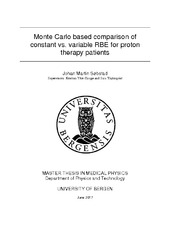| dc.description.abstract | Around the world, the use of protons as an alternative to photons radiation therapy of cancer is becoming more widespread. The motivations for this is that protons enable a reduction of the radiation dose to health tissue or increase the dose to the tumor when compared to photons. However, there is currently an uncertainty related to the biological effectiveness of protons. Protons are known to be slightly more efficient in cell inactivation then photons, and this can be taken into account by applying a scaling factor for the proton dose. The scaling factor is known as the relative biological effectiveness (RBE) and in current clinical practice a constant RBE factor of 1.1 is applied. However, several studies including data from cell irradiation experiments suggest that a variable RBE factor is more appropriate. The primary objective of this project was to calculate and compare the dose-to-patient results of constant RBE versus variable RBE calculated by different models for protons. The calculations were done by a combination of FLUKA Monte Carlo (MC) simulations and post-processing using custom scrips written in Python. CT images and treatment plan information for a medulloblastoma patient was imported into FLUKA, where the dose and linear energy transfer (LET) was calculated. The RBE values were subsequently calculated for four different models, assuming constant tissue parameters. An in-depth investigation of the different model properties was performed by systematically varying the model parameters. RBE calculations with a simple treatment plan on a water phantom were also performed. The models consistently predicted an equal or lower dose in the beam-entrance region compared to predictions for RBE = 1.1 (RBE1.1) while greatly exceeding the predicted RBE1.1 dose in the distal part of the PTV and in the distal dose-falloff. There was also a considerable increase in dose distributed in the lateral direction for the PTV. The dose volume histograms (DVHs) revealed that structures/OARs located in close proximity to the PTV receive considerably higher levels of dose than predicted by RBE1.1 due to a high RBE factor, at times double that of the constant RBE. The RBE models also show a strong dependence on dose. The models appear to be largely in agreement, and the mean RBE varies about 1.4% in the PTV. However, the mean RBE variation increases at lower doses, such as in the esophagus with 6.3% variation. For a prescribed dose of 23.4 Gy to the PTV, the mean dose to the PTV varied between 24.9 and 25.7 for the different models, while for the lungs and esophagus the mean dose varied between 3.79-4.03 and 10.2-11.5, respectively. The results show that while the models do have differences, they consistently deviate from the dose predicted using RBE of 1.1. For the investigated patient case RBE values from 1.1 to 1.4 were seen for the target volume, while similar and higher RBE values were also observed for several healthy tissues, and this could be of clinical relevance. This leads to the conclusion that implementing a variable RBE into clinical scenarios should be considered. At least, practitioners should use the results provided by MC as guidance for assessing the dose until more experimental data and accurate models becomes available. | en_US |
